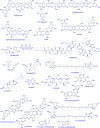Commercial importance of seaweeds: an overview
- PMID: 41144161
- PMCID: PMC12559517
- DOI: 10.1186/s40643-025-00944-y
Commercial importance of seaweeds: an overview
Abstract
Seaweeds, a vital source of marine ecosystems, are gaining popularity for their importance in ecological, economic, and industrial applications. These are profusely found in coastal areas due to the promising environmental factors. Various biochemical compounds, such as polysaccharides, proteins, lipids, and bioactive chemicals, are present in seaweed, which is useful in numerous industrial applications. Moreover, seaweeds are becoming a useful resource for addressing various environmental sustainability issues and food security, hydrocolloids to functional foods and nutraceuticals. Therefore, the cultivation and harvesting of seaweed using advanced and unique techniques are expanding globally for its efficient and sustainable production. In-depth understanding of the structural variation of seaweed, its taxonomy, and adaptation mechanisms is essential to evaluate its importance in the marine ecosystem. This review focused on botany, advanced farming techniques, and industrial prospects of seaweed, that especially emphasize the role of seaweed products in promoting a sustainable food industry. Further, this review also elaborates on various functional foods, bioactive compounds, and hydrocolloids derived from seaweed to improve food security and promote good health conditions. Besides this, insights into seaweed products for sustainable industrial application of seaweed are also emphasized in this review to address various issues related to global food systems, economic development, and environmental preservation.
Keywords: Biochemical compound; Hydrocolloids; Marine ecosystem; Nutraceuticals; Sustainable.
© 2025. The Author(s).
Conflict of interest statement
Declarations. Ethics approval and consent to participate: Not applicable. Consent for publication: Not applicable. Competing interests: The authors declare that they have no competing interests.
Figures
References
-
- Abdel-Kareem MS, ElSaied AA (2022) Global seaweeds diversity. In: Abdel-Kareem MS, ElSaied AA (eds) Handbook of algal biofuels. Elsevier, Berlin/Heidelberg, pp 39–55
-
- Abirami RG, Kowsalya S (2012) Phytochemical screening, microbial load and antimicrobial activity of underexploited seaweeds. Int Res J Microbiol 3(10):328–332
-
- Abirami RG, Kowsalya S (2013) Antidiabetic activity of Ulva fasciata and its impact on carbohydrate metabolism enzymes in alloxan induced diabetic rats. Int J Res Pharm Phytochem 3(3):136–141
-
- Abreu MH, Pereira R, Yarish C, Buschmann AH, Sousa-Pinto I (2011) IMTA with Gracilaria vermiculophylla: productivity and nutrient removal performance of the seaweed in a land-based pilot scale system. Aquac 312(1–4):77–87. 10.1016/j.aquaculture.2010.12.036
-
- Akazawa T, Hara-Nishimura I (1985) Topographic aspects of biosynthesis, extracellular secretion, and intracellular storage of proteins in plant cells. Annu Rev Plant Physiol 36:441–472
Publication types
LinkOut - more resources
Full Text Sources





